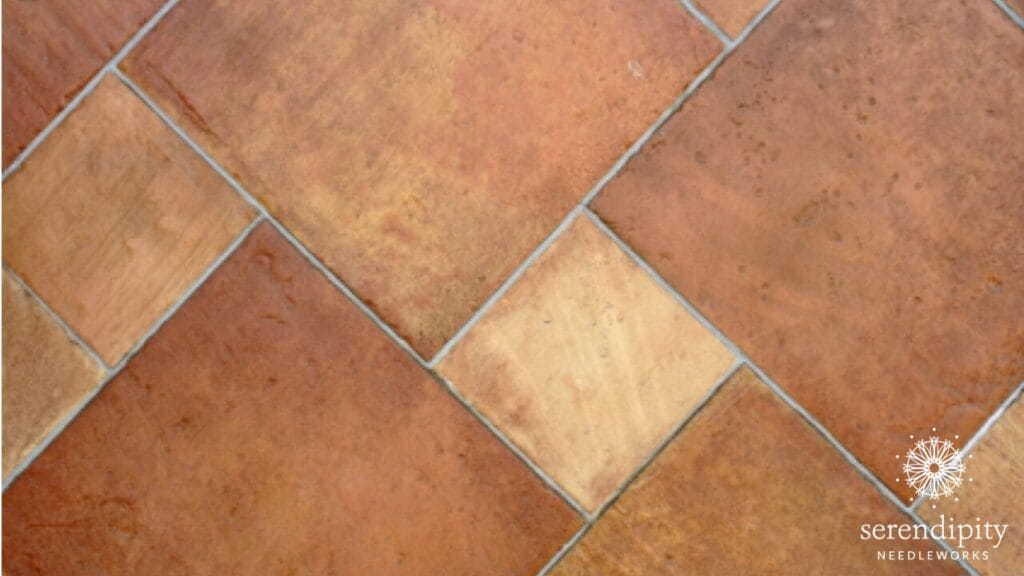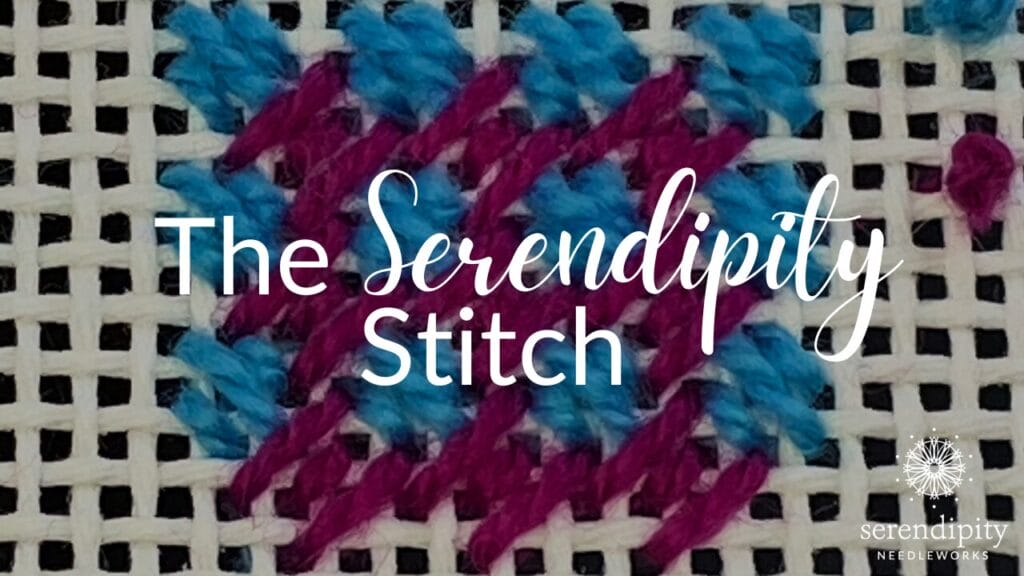Ready to explore another terrific stitch you can use on your needlepoint projects? Terrific! Today, we’re taking a closer look at the serendipity stitch…
The serendipity stitch is a member of the straight stitch family.
Straight stitches are those that lay in a horizontal, vertical, or diagonal direction on your canvas. In other words, they are not distorted, knotted, or woven, nor do they lay across another stitch.
The serendipity stitch has a satin pathway. That means your stitching thread encircles the canvas threads as you progress through the stitch pattern, often leaving as much thread on the back as you have on the front. And in case you’re not familiar with stitch pathways, here’s a simple definition for you – stitch pathways are the order and direction in which you execute the stitches in a pattern.
I’m hosting a brand new event in July – Summer Stitch Camp – where you can learn more about stitch pathways and stitch families.
Not sure why you need to know about those things? Well, understanding the different pathways a stitch can take helps you “decode” stitch diagrams without numbers and letters. And when you can identify which family a stitch belongs to, it’s easier for you to choose stitches that work well together on your projects.
And speaking of stitches that work well together on your projects…
The serendipity stitch is a “kissing cousin” to the criss-cross Hungarian stitch.
In fact, I often use them together on the same project because they “play well together”. For example, since the serendipity stitch is not as large as the criss-cross Hungarian stitch, you can use it on smaller design components on the canvas – or you can use it to convey a sense of distance or perspective.
Here’s the diagram for you…

This stitch diagram has both numbers and letters on it because it’s a two-step stitch. Work the stitches labeled with numbers first, then complete the pattern by filling in the gaps with the stitches labeled with uppercase letters.
I typically begin on the right side of the area I’m covering with this stitch since I’m my right hand is my dominant hand. If your left hand is your dominant hand, begin on the left side and reverse the number sequence.
One of my favorite ways to use the serendipity stitch is for thatched rooftops.

You can completely change the way this stitch looks with your thread choice, so let’s take a peek at some different options. Thatched rooftops have a very rough texture. They are, after all, made by layering densely packed straw, reeds, and rushes so as to shed water away from the inner roof.
Some terrific threads for thatched roofs include Straw Silk, Rainbow Tweed, Rainbow Linen, Mandarin Floss, and Watercolours.
Think about mixing threads for extra texture and visual interest. For example, you could use two different shades of Watercolours to add depth to the rooftop. “Mahogany” (#174) and “Sable” (#196) make a nice combination.
Rainbow Tweed RT34, RT35, or RT36 would all make exceptional thatched rooftops, as would Rainbow Linen (R457, R458, R466, R480, R481, and R490).
And you might even mix a strand of Rainbow Tweed and a strand or two of Rainbow Linen in the same needle for an especially interesting effect.
You can use the serendipity stitch for tile and parquet floors, too.

Weeks Dye Works Hand Over Dyed Embroidery Floss boasts a range of colors that are very subtle . As they state on their website, the “colors are variegated enough to be noticeable, yet subtle enough to blend naturally.” That’s my kind of multi-colored thread! In fact, because the shift of color is so slight, you can actually come back and compensate later when stitching with many of their hues (instead of compensating as you go).
Other thread options for tile and parquet floors include Threadworx Overdyed Floss, Waterlilies, and Gloriana 12 Strand Silk. And if you prefer working with solid colors of thread, Soie Cristale, Mandarin Floss, and DMC cotton embroidery floss offer a wide range of hues.
Since tile floors can be just about any color under the rainbow, my best suggestion is to match your thread to the color of paint on your canvas. Parquet floors, on the other hand, are almost always natural wood tones. Here are a few ideas to help you get started stitching some wonderful wood flooring: Waterlilies “Gingersnap” (#189), Threadworx Overdyed Floss “Wet Clay” (#1028) or “Rich Chocolate” (#10371), and Gloriana 12 Strand Silk “Honey Bronze” (#107) or “Milk Chocolate” (#170).
Alrighty, my friend – that brings us to the end of our chat about the serendipity stitch. If you’d like to watch a demonstration of how to do the serendipity stitch, hop over to our Serendipity Needleworks YouTube channel and watch this episode of Needlepoint TV! (And if you haven’t already subscribed, be sure to do that to. Just click the black “subscribe” button to receive notices every time a new episode airs. 😉 )
Until next time, happy stitching…
XOXO!






Love that you provide ideas for use and fiber suggestions!
I’m so glad you found it helpful, Abigail! 😉
XOXO
Ellen
I’m needing a new project….. hummm…. Were would I be able to purchase some thing ?
Hi Patty!
What kind of design are you interested in stitching?
Looking forward to hearing from you soon…
Ellen